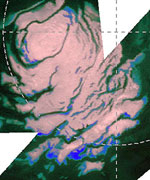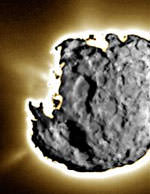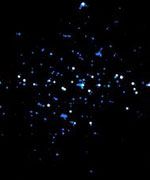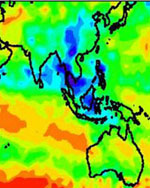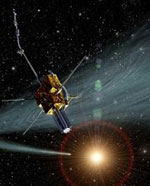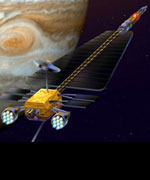
Image credit: NASA/JPL
NASA has a new partner in its mission to explore the universe and search for life.
The Department of Energy’s (DOE) Naval Reactors (NR) Program joins NASA in its effort to investigate and develop space nuclear power and propulsion technologies for civilian applications. These activities could enable unprecedented space exploration missions and scientific return unachievable with current technology.
NR brings 50-plus years of practical experience in developing safe, rugged, reliable, compact and long-lived reactor systems designed to operate in unforgiving environments. NR is a joint DOE and Department of the Navy organization responsible for all aspects of naval nuclear propulsion.
The partnership is responsible for developing the first NASA spacecraft, the Jupiter Icy Moons Orbiter (JIMO), that will take advantage of a nuclear-reactor energy source for exploring our solar system. JIMO will visit Jupiter’s three icy moons, Ganymede, Callisto and Europa. These icy worlds, in particular Europa, are believed to have liquid-water oceans, under a thick layer of ice on their surfaces, which could potentially harbor life.
The reactor system will provide substantially more electrical power. This will greatly enhance the capability of ion-drive propulsion, the number and variety of scientific instruments on the spacecraft, the rate of data transmission, and orbital maneuvering around Jupiter’s moons.
NASA sought this partnership because NR has an enduring commitment to safety and environmental stewardship that is a requirement for an undertaking of this magnitude, ” said NASA Administrator Sean O’Keefe.
“This partnership will help ensure the safe development and use of a space-fission reactor to enable unparalleled science and discovery as we explore the solar system and beyond. This work is an integral piece of the President’s exploration agenda,” Administrator O’Keefe said.
NASA, through its newly created Office of Exploration Systems, expects that several reactor modules of the same or similar design as that required for JIMO would be developed for use on future exploration missions. NR will direct and oversee the development, design and delivery of, and operational support for these civilian reactor modules.
The Office of Nuclear Energy, Science and Technology, another DOE organization with extensive nuclear-reactor development experience, will retain responsibility for supporting NASA’s other space nuclear technology efforts, including long-term space-reactor science and technology development not associated with NR’s responsibilities.
All activities in support of NASA will be conducted as part of NR’s civilian responsibilities for the National Nuclear Security Administration, a semi-autonomous agency of DOE. Activities in support of NASA are not part of NR’s Navy responsibilities or any Department of Defense activities. This partnership with NASA is consistent with NR’s history of supporting fission-reactor work for civilian applications, including the first U.S. commercial production of electricity from nuclear power at the Shippingport Atomic Power Station.
NASA will fund all work under the partnership. Specific roles and responsibilities will be defined in Memoranda of Understanding and Agreements currently being drafted by NASA and NR. NR and the DOE Office of Nuclear Energy will also review capabilities and facilities at DOE laboratories outside NR for consideration in support of JIMO and other Project Prometheus activities.
Established in 2003, Project Prometheus is developing radioisotope electric power sources for use in space and on planets or moons, as well as new fission-reactor power sources for advanced missions into deep space requiring higher power levels for science observations, propulsion, communications and life support systems.
More information on Project Prometheus is available at:
http://spacescience.nasa.gov/missions/prometheus.htm
More information on the Jupiter Icy Moons Orbiter is available at:
http://spacescience.nasa.gov/missions/JIMO.pdf
Original Source: NASA News Release

